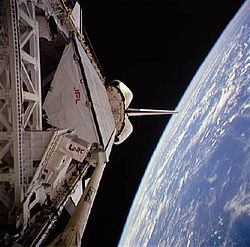
The first Space Radar Laboratory (SRL-1) in Endeavour’s payload bay. Tom Jones flew both the first and second missions of the radar lab. Photo Credit: NASA
Twenty-five years ago this week, the crew of Endeavour on STS-59 demonstrated that the shuttle program was imbued with “Radar Love”, as they operated the first Space Radar Laboratory (SRL-1) to acquire unprecedented views of the Home Planet from orbit. For 11 days, astronauts Sid Gutierrez, Kevin Chilton, Jay Apt, Rich Clifford, Linda Godwin and Tom Jones worked around the clock to ensure that the radar instruments of the SRL-1 payload gathered an enormous quantity of scientific data. Much of that data is still being analyzed to this day and has helped to shape our understanding of Earth’s past, present and, potentially, its future.
SRL-1 had its genesis in the Shuttle Imaging Radar (SIR), which first flew aboard STS-2 in November 1981. However, the capabilities of SIR-A were left undemonstrated, because the scheduled five-day mission was cut short by a fuel cell malfunction and shuttle Columbia returned to Earth after just 54 hours. Three years later, however, it flew again aboard Challenger on STS-41G as SIR-B and its success provoked astonishment. Over an eight-day period in October 1984, it identified ancient caravan trails in Arabia, allowed geologists to construct three-dimensional maps of subtle features on California’s Mount Shasta, permitted contour modeling of parts of eastern and southern Africa, and examined intricate structural features, including fault-lines, folds, fractures, dunes, and rock layers. By this time, at least two more missions of the shuttle-ferried radar were planned, but had been extensively delayed. On the eve of the Challenger disaster, SIR-C was scheduled to form part of SRL-1 and scheduled for launch on STS-72A in March 1987 from Vandenberg Air Force Base, Calif. The payload would have operated from a near-polar inclination of 88 degrees, offering its radar instruments a broad imaging swathe across most of Earth’s landmasses.
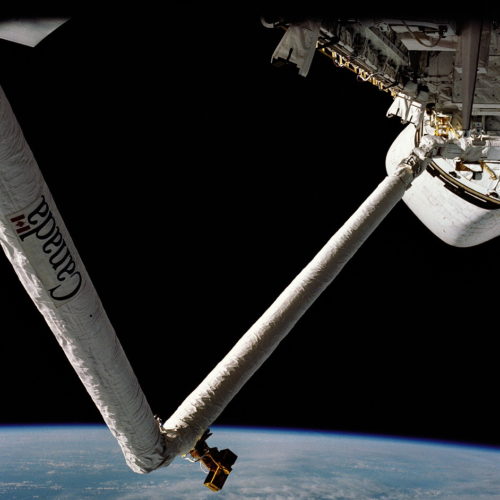
The Shuttle Imaging Radar flew its maiden voyage, as SIR-A, on the second shuttle mission in November 1981. Photo Credit: NASA, via Joachim Becker/SpaceFacts.de
In the aftermath of Challenger, all Vandenberg missions were suspended (and ultimately canceled) and the launch site for SRL-1 changed to the Kennedy Space Center (KSC) on Florida’s East Coast. This meant that the maximum achievable orbital inclination for the mission was 57 degrees. The imaging radar would map a substantial portion of Earth, including regions as far north as Juneau, Alaska, and a little farther south than Tierra del Fuego, at the southernmost tip of Argentina. The STS-59 crew was assigned at several stages, with Godwin named as payload commander—having overall responsibility for the scientific goals of the mission—in August 1991 and joined by Jones in early 1992. A year later, the other astronauts were announced. Only Apt and Clifford had previously flown to an inclination as high as 57 degrees and both were acutely aware of its usefulness for Earth observations and mapping.
In fact, Apt wrote extensively about the experience in his book Orbit, co-authored with Justin Wilkinson and Michael Helfert. “On my first space flight,” Apt wrote, “I flew no farther north than the glorious Himalaya. I shot photo after photo of Tibet, with the Sun low in the sky and the shadows long. Central and northern Asia were a mystery to me. On my second and third flights, I was on the flight deck for a 12-hour shift, when it was “night” in Houston and “day” in Asia. We flew over almost the entire continent.”
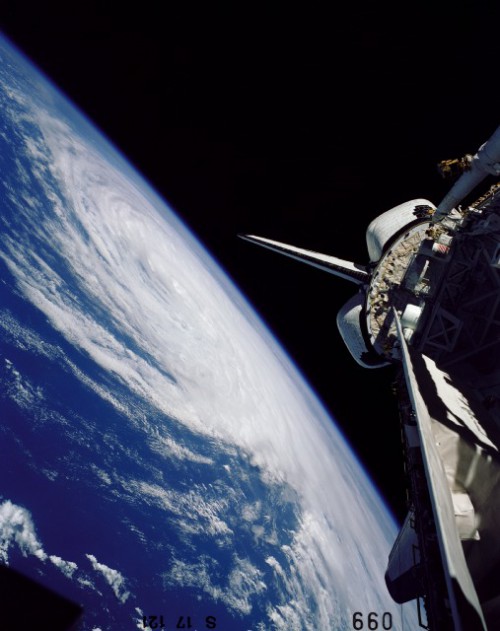
The Shuttle Imaging Radar (SIR)-B antenna aboard Challenger’s payload bay during Mission 41G. Photo Credit: NASA
To understand how the SRL-1 payload evolved, it is important to comprehend the accomplishments of the SIR-A and SIR-B radars. The first mission in November 1981 was restricted to recording the ground-track directly “beneath” the orbiter, but in preparation for SIR-B the radar was engineered to “tilt” at angles between 15 and 57 degrees to the side and its imaging resolution was enhanced from 130 feet (40 meters) to 80 feet (25 meters). By varying its “look” angle in this fashion, it became possible to assemble “mosaics” of adjacent surface features, collected over periods of several days. The third mission, SIR-C, offered multi-frequency, multi-polarization imagery and represented the first spaceborne radar with the ability to transmit and receive horizontally and vertically polarised waves at both the L-band and C-band wavelengths.
Measuring 39 feet (12 meters) long and weighing 23,150 pounds (10,500 kg), SIR-C was the most massive piece of flight hardware ever built at the Jet Propulsion Laboratory (JPL) in Pasadena, Calif. “Synthetic-aperture radar technology,” explained Tom Jones in his memoir, “uses the motion of a spacecraft or aircraft to electronically synthesize an antenna much larger than its physical size, yielding higher imaging resolution.” However, SIR-C was not the only radar aboard SRL-1. Running like a strip along the uppermost edge of SIR-C was the “X-SAR” synthetic-aperture radar, built by a partnership of organizations, including the German Dornier and Italian Aleniz Spazio companies, together with the German and Italian space agencies, which offered a single-polarization radar, operating in the X-band.
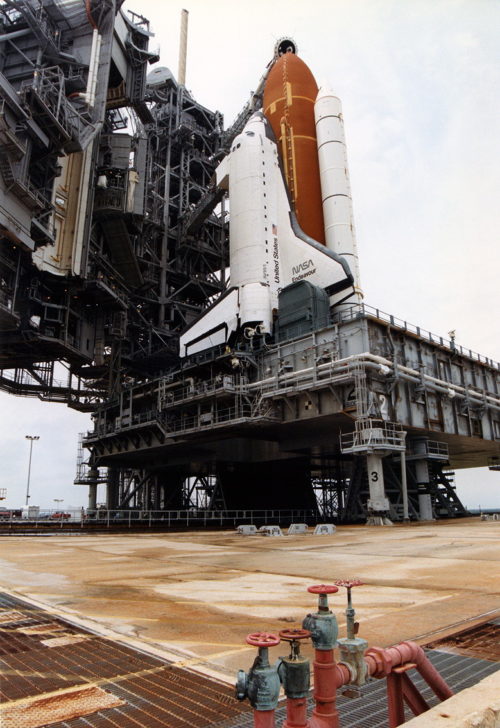
Endeavour arrives at the launch pad, ahead of STS-59. Photo Credit: NASA, via Joachim Becker/SpaceFacts.de
Before launch, NASA’s SRL-1 press kit noted that resolutions as high as 33 feet (10 meters) were a possibility. Throughout the projected nine-day mission, the combined SIR-C/X-SAR imaging suite was expected to make around 50 hours of observations, covering more than 19.3 million miles2 (50 million km2), acquiring 32 terabytes of raw data, and storing it all on 180 cassettes, using three high-density, digital, rotary-head tape recorders. Both radars would work together to acquire the best possible data.
Although the United States, Germany and Italy were involved in the development of the payload, more than 50 investigators from 13 nations provided experiments and investigations as part of the science team. Also operating as part of the payload was an instrument called the Measurement of Air Pollution from Satellite (MAPS), which sought to measure global distributions of carbon monoxide in the troposphere, where Earth’s weather system is most active, and it had already pointed to a worrisome trend that greenhouse gases had become increasingly severe throughout the early part of the 1980s. MAPS also highlighted disturbing levels of pollution—particularly in the tropics—due to the seasonal burning of biomass.
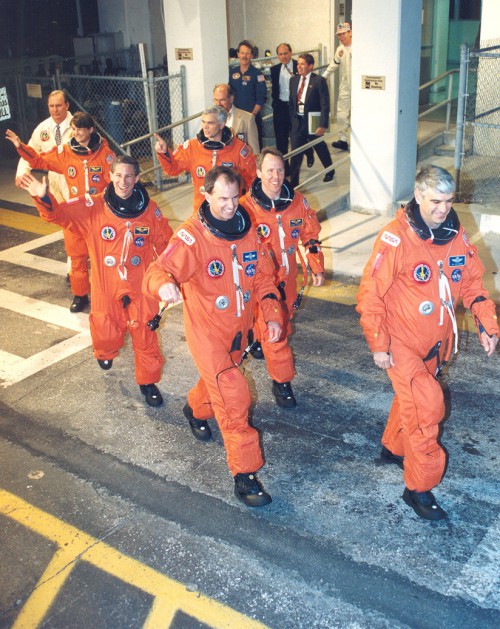
Tom Jones (second from right) and the STS-59 crew head to the launch pad on 9 April 1994. Photo Credit: NASA, via Joachim Becker/SpaceFacts.de
SRL-1 would not be scanning the planet in an indiscriminate fashion. Rather, a series of 19 “super-sites” of particular geological, hydrological or ecological interest were selected and would be observed during daily radar passes. During the SRL-1 mission, “ground-truth” teams at various sites undertook measurements of vegetation, soil moisture, sea state, snow cover and weather conditions to correlate with the shuttle data.
To accomplish around-the-clock science, Gutierrez split the crew into “red” and “blue” shifts, with himself in charge of the red team, joined by Godwin and Chilton, and Apt leading the blue team, accompanied by Clifford and Jones. “He needed the two pilots on the same sleep cycle,” Jones explained, “both fresh and wide awake for launch and landing days. Linda would join them, enabling Sid to get the payload commander’s input on any experiment or orbiter problems without having to wake the opposite shift.”
According to the STS-59 press kit, launch was scheduled for 7 April 1994, but an inspection of a shuttle main engine at Rocketdyne’s facility in Canoga Park, Calif., had found that the critical dimensions of nickel-alloy liquid oxygen guide vanes in the turbopump preburner were “out of tolerance”. Inspectors found that two components had sharp, rather than rounded, tips, presented an increased possibility of fragmentation, which increased the likelihood of a premature shutdown. “A thinned or deformed vane,” explained Jones, “could break off in the oxidizer flow, shattering the turbopump blades downstream.”
A 24-hour delay was enforced to offer technicians the opportunity to examine Endeavour’s vanes, which turned out to be in the proper configuration. The delay proved fortuitous, for Chilton contracted a virus and had to be placed under observation, “isolated” even from his already-isolated crewmates in quarantine. “It was a race,” wrote Jones, “between Chili’s recuperative powers and the ticking countdown clock.” By the 7th, Chilton had recovered sufficiently to rejoin the rest of the crew. High winds the following morning threatened the launch. Overcast conditions led the Mission Management Team to lengthen the “hold” in the countdown at T-9 minutes, and, eventually, late in the 2.5-hour “window”, the clouds began to clear. Unfortunately, this break was accompanied by an increase in wind speed, which exceeded the maximum allowable limit for a Return to Launch Site (RTLS) abort at the Shuttle Landing Facility (SLF).
Jones tried to invoke St. Theresa, patron saint of aviators, and St. Joseph of Cupertino, the patron saint of astronauts, for their help. Suddenly, the cabin fell silent. Then Gutierrez spoke. “What’s St. Joseph of Cupertino got to do with astronauts?” he asked.
“Well,” Jones replied, “he used to levitate over the altar of his monastery chapel. He discovered zero-G three hundred years ago!”
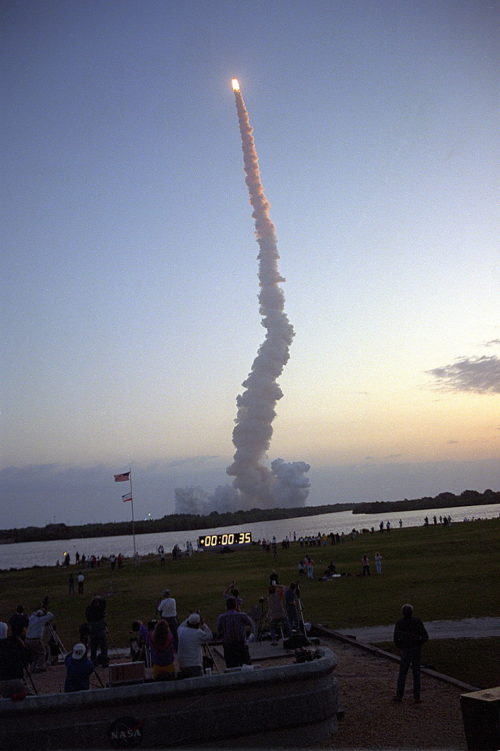
Endeavour roars to orbit on 9 April 1994. Photo Credit: NASA, via Joachim Becker/SpaceFacts.de
They gave it a try, but alas it was not to be, and the weather gods were just too strong on 8 April. With the winds continuing to gust out of limits, Launch Director Bob Sieck ordered a scrub. Liftoff was rescheduled for 7:05 a.m. EDT on the 9th, and it was six anxious astronauts who climbed aboard Endeavour that morning, as another scrub would produce a conflict with other scheduled launches on the Eastern Range and effect a delay until at least the 23rd. Lying uncomfortably on their backs, they listened to the milestones over the intercom. By 6:56 am, as Endeavour emerged from the last scheduled “hold” in the countdown at T-9 minutes, they tightened their harnesses and steeled themselves for the controlled explosion that would soon come. At T-5 minutes, Chilton leaned over from the pilot’s seat and flipped a trio of switches to activate the orbiter’s Auxiliary Power Units (APUs). Endeavour now had hydraulic muscle.
In the acronym-laden minutes which followed, the astronauts were instructed to close and lock their helmet visors and activate the flow of oxygen into their suits. Albuquerque-born Gutierrez, the only shuttle commander of Hispanic ancestry, led his team in their final “comm” checks and was wished “Vaya con Dios”—“Godspeed”—by launch controllers as a last send-off. At T-31 seconds came the “Go” for autosequence start, as Endeavour’s computers assumed primary command of vehicle critical functions. Fifteen seconds later, navigational indicators on the instrument panel snapped into their correct launch-ready positions. “Nav init,” confirmed Gutierrez.
At seven seconds, the swirling sparks of the hydrogen burn igniters gave way to a familiar rumble and sheet of translucent orange flame, as the three main engines roared to life, quickly reaching full power and producing three dancing Mach diamonds. “Three at a hundred!” yelled Chilton over the growing crescendo. Finally, at T-zero, the twin boosters flared plumes of brilliant orange flame and the STS-59 crew received a smart punch in the back as they departed Planet Earth on a mission to study Planet Earth. The second part of this article will appear next weekend.
.
.
FOLLOW AmericaSpace on Facebook and Twitter!
.
.




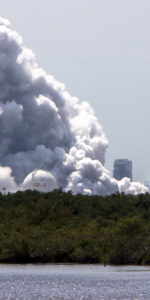
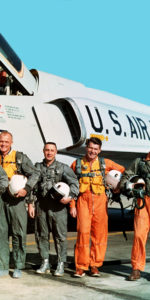
2 Comments
2 Pings & Trackbacks
Pingback:‘A Vision of Pure Beauty’: Remembering STS-59, 25 Years On (Part 2) « AmericaSpace
Pingback:'A Vision of Pure Beauty': Remembering STS-59, 25 Years On (Part 2)